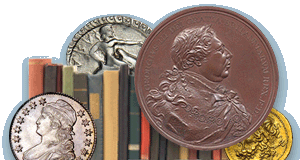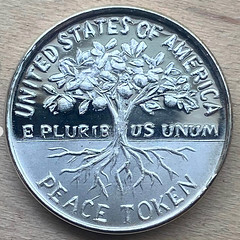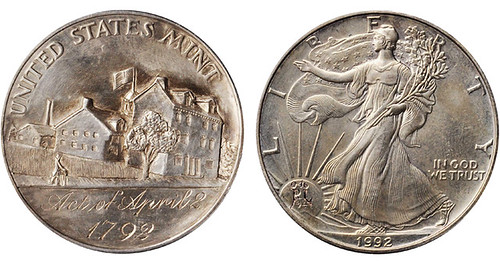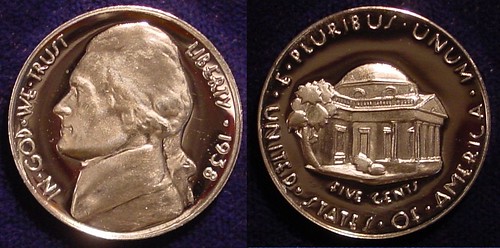
PREV ARTICLE
NEXT ARTICLE
FULL ISSUE
PREV FULL ISSUE
RONALD WAYNE LANDIS (1954-2025)Ron Landis of the Gallery Mint has died. The prolific Eureka Springs AR musician, artist, engraver and minting expert was born March 25, 1954 and died June 17, 2025. -Editor
"You may or may not know me, however it is my tearful duty to let everyone know that Ron Landis has left us and joined the Heavenly Chorus, likely in the musicians pit playing dobro or banjo! "I will continue to post updates regarding any of his public affairs in the short term. If there are any specific needs or requests, I will be monitoring his Facebook Messenger as well as our email rlandis.studios@gmail.com. "Ron's legacy will continue to thrive. As his instruments are played by the many folks he jammed with and loved as well as Landis Studios continuing to craft his inspired designs." Below is an extensive overview of Ron's life and career from the Landis Studios website. -Editor Ron Landis' love affair with the arts began as a child when he first became fascinated with coins and engravings. During his school years, Ron explored many facets of crafts and arts and won a Blue Ribbon in the Scholastic Arts Awards his senior year for a heavily ornamented banjo he built in school. It was that interest in building banjos that led him to pursue the art of hand engraving so he could apply those skills to further ornament the instruments he wanted to build. Ron attended Gem City College in Quincy, Illinois, in the late 1970s, where he learned watch repair, diamond setting and hand engraving. From there, he returned to his hometown of Denver, where he apprenticed for a short time under the late George Bickley, a highly respected jewelry engraver. Ron operated his own jewelry engraving shop for a few years before he was talked into sharing a booth at the Colorado Renaissance Fair with a seamstress who planned to make hats. Wanting to keep his wares on display there in theme with the festival, Landis offered custom-engraved wax seals and learned how to sculpt backwards into metal so the wax impressions it made would be three-dimensional – just like on coins. That led him to realize that if he could engrave steel in the same manner, he could somehow make souvenir coins from those engravings. So he soon took a short walk to his local scrap yard with graver in hand, and after a few cuts into the end of a round bar, he purchased it for $1 – which was his initial investment into what would become a lifelong pursuit. Landis then acquired a small fly press from one of his engraving clients, who traded for $25 worth of engraving. For the next ten years, that press was used to strike souvenir medals at numerous Renaissance Festivals all across the United States. In an effort to make his coin-making demonstration more interesting and more authentic to the Renaissance period, Ron added more equipment such as rolling mills, intaglio printing press, and an early-style edge mill that he built from scratch to apply lettered edges to his medallions. His attention to detail and his studies of early mint technologies garnered the attention of the late Dr. Richard Doty, senior curator of the Smithsonian Institution's National Museum of American History. Doty recommended Ron for an enormous project underway in Segovia, Spain: to restore the ruins of the 16th Century Royal Mint of Spain. Ron assisted in that effort from 1988-89 with conceptual drawings and plans that were eventually employed to restore the ruins of the Royal Mint into a museum of coin-making. Ron's passion for learning about early coin-making methods grew. From 1989-90, he built a 1200-square-foot demonstration for the Texas Renaissance Festival featuring a water wheel that pumped bellows for the melting furnace and powered rolling mills similar to the kind used in Segovia, Spain. The comprehensive demonstration explained coin-making methods of Ancient Greece and the Renaissance Period, when new mechanical inventions began to appear on the scene. He also built a large drop hammer – a fantasy machine of his own design – and struck limited-edition silver medals with raised lettering around the edge. The Renaissance Mint provided the impetus for machinist Joe Rust to become interested, so Ron and Joe formed a partnership and decided their efforts would be better served as a stand-alone attraction away from the theme park setting. In 1992, they moved to Eureka Springs, Arkansas, with the goal of building a museum of minting technology. The resulting Gallery Mint Museum quickly gained the attention of coin collectors and numismatists around the world who were excited to explore the new information and methods resulting from the partners' trial-and-error research into die sinking and coin manufacturing, and how it evolved through the ages. Gallery Mint was mostly noted for its high-quality reproductions of early U.S. and Colonial coins made using the same methods as were used long ago to create the originals. In this manner, Ron and Joe could gain more insight into the subject through actual hands-on experience with given methods. The two were able to form a greater understanding of a subject that had historically been suppressed for obvious reasons. All Gallery Mint reproductions carry a COPY stamp as mandated through the federal Hobby Protection Act. Highlights of Ron's career include the designing and making of prototypes that were distributed to members of Congress during their discussion of legislation for the new "Golden Mini Dollar" being proposed. Two previous bills to create a new dollar coin to replace the Susan B. Anthony had failed. Many have credited Ron's prototypes with leading to the passing of legislation to create the new coin. Although Ron's classic Liberty Head design was the 80% favorite among coin collectors, the concept of Lady Liberty was not chosen. He received a standing ovation for his plea to the design commission in Philadelphia, but it was decided that Sacagawea was to be the subject on the new coin. Ron was invited by the U.S. Treasury to submit designs for the Sacagawea Dollar, along with several other designers. Ron is also known in some circles as the "Grandfather of the Modern Hobo Nickel Movement." His interest in this obscure folk art prompted him to see if he could alter nickels into more creative and artistic creations than the standard Bearded Man with Hat themes of the traditional Hobo Nickels. For three years, Ron was the only one carving coins in high quality. The art had almost died out completely when Ron tried to transform it into something more like medallic sculpture as opposed to folk art. Slowly, other engravers of various levels joined in. Today, there are countless people around the world engaging in the art, using all kinds of coins and employing advanced skills and methods combined with brilliant new concepts. In 2005, Ron lost his beloved friend, Joe Rust, who had long been Ron's partner in business and in music. Three years later, Ron had a car accident. The series of events caused a domino effect, and he suffered severe depression, which lasted for several years. Now, after a heart operation and plenty of good music, Ron is back with renewed optimism and more creative ideas than ever before. The newly formed Landis Studios is joined by his old friend, Mr. Timothy Grat, a machinist with engineering skills and coin-making experience too vast to list in this already too long page. I don't hang out on social media much, but I do check Facebook almost daily and came to enjoy Ron's updates on his musical engagements. He greatly enjoyed playing and didn't let age or health slow him down, always looking forward to the next gig. -Editor Jud Petrie writes: "Of the many memories I have of Ron Landis the one that sticks out in my mind the most was the day he received the Glenn Smedley Award when he jokingly threatened to 'hobo' it. At least I think he was joking." Here's an example of Ron's detailed nickel carving from an article by Carol Bastable in the Summer 2013 issue of Bo Tales, the journal of the Original Hobo Nickel Society. -Editor
The skill level involved in making these coins is amazing. Many equal or even surpass the best classic cameo hobo nickels. However, remember that most are made by trained artists and professional engravers verses itinerant laborers. Also, the modern age has provided all sorts of fancy equipment to aid in these works of art, such as air powered gravers, microscopes, and at the very least, jeweler's visors. Through creativity, ingenuity, and technology, today's collector has some magnificent selections to choose from.
To read the earlier E-Sylum article, see:
Landis also produced dies for the 1855 Kellogg & Co. $50 gold restrikes made with gold recovered from the S.S. Central America. -Editor
These 500 coins are commemorative re-strikes of the historical 1855 Kellogg & Co. $50 gold pieces. On each day, from August 20 to September 12, 2001, a total of 5,000 of these commemoratives were produced for California Gold Marketing Group by personnel from The Gallery Mint: Ron Landis, Joe Rust and their staff. The coins were minted at The Presidio in San Francisco, commemorating the anniversary of the departure of the S.S. Central America gold from San Francisco, its voyage to Panama, the crossing of the isthmus, and its northbound voyage until lost in the shipwreck. Landis and Rust used a transfer technique to produce the dies for the re-strikes, expertly copying the original dies from Kellogg, which had survived. The gold for these coins was derived from Kellogg & Humbert ingots recovered from the S.S. Central America, thus using Kellogg gold to re-produce Kellogg's design. The faces of the ingots, known in numismatic circles now as "faceplates," were saved, and can be found here and there on bourse floors and in auctions. Attached are photos of the obverse and reverse of a re-strike, in this case produced on August 20, 2001, as counterstamped on the reverse. All of the commemoratives are similarly counterstamped with their production dates.
To read the earlier E-Sylum article, see:
Here are some more examples of Ron's work. -Editor There will be a Celebration of Life for Ron Landis hosted by Sprungbilly & Gravel Bar at Wanderoo Lodge in Eureka Springs Monday June 23rd from 7-10pm. -Editor
For more information, see:
To read earlier E-Sylum articles, see:
Wayne Homren, Editor The Numismatic Bibliomania Society is a non-profit organization promoting numismatic literature. See our web site at coinbooks.org. To submit items for publication in The E-Sylum, write to the Editor at this address: whomren@gmail.com To subscribe go to: Subscribe All Rights Reserved. NBS Home Page Contact the NBS webmaster 
|













